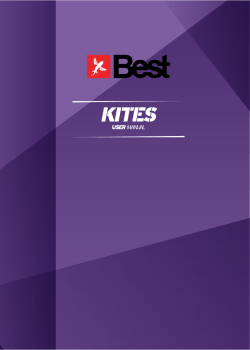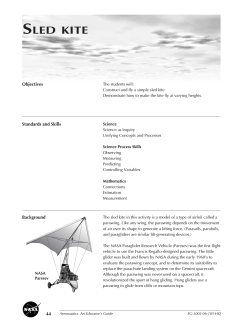
ABC Music & Me who have been teaching award-winning
ABC Music & Me is a program created by the folks at Kindermusik who have been teaching award-winning classes for parents and children for over 30 years. ABC Music & Me is proud to be helping children, teachers, and families build listening and early literacy skills through music, storytime, and movement activities! To learn more visit us at: www.abcmusicandme.com Reading, writing, listening, and speaking activities created by Simone T. Ribke. The ABC Music & Me™ Family Guide is published by Kindermusik® International, 203 South Church Street, Greensboro, NC 27214. Published as the Family Guide to the Up in the Sky unit, part of the ABC Music & Me™ program. Copyright 2011, 2008, 2004 Kindermusik® International. All rights reserved, including right of reproduction in whole or in part, in any form. Printed in the United States of America. Up in the Sky Listen up! (p. 2) Take a “bird walk” (p. 4) Up, up, and away! (p. 10) The windy day Drums, drums, drums! (p. 17) (p. 5) Who’s in the night sky? (p. 8) This month’s learning focus: A day in the life of a robin (p. 5) ABC Music & Me is more than just a music class—it’s a learning class. Research indicates the importance of music at a very early age, and ABC Music & Me has created a carefully planned program to enhance each child’s learning and growth during these important early years. When young children sing, play, move, and interact in their ABC Music & Me class, the sounds, rhythms, and movements of the activities enhance their emotional, social, physical, and cognitive growth. Inhibitions fall away, self-esteem grows, and social skills develop. Through moving, dancing, and playing instruments, children also develop muscle control and coordination. Each ABC Music & Me lesson includes a strong literature component, encouraging the development of important skills such as listening, sequencing, anticipation, empathy, and literacy. ABC Music & Me helps children learn how to learn, and have fun while they’re at it! Every ABC Music & Me lesson contains a variety of activities designed to encourage many different kinds of learning: • Greeting and Goodbye Rituals help children feel comfortable, individually recognized, and ready for learning. • Singing is a natural way for children to express their innate creativity and growing sense of rhythm and melody. • Vocal Play helps children develop expressiveness and confidence when speaking. • Movement activities help children develop coordination and rhythm. • Instrument Exploration and Play-Along activities help young children practice fine-motor skills and experiment with sounds, rhythms, and steady beats. • Storytime exposes children to new vocabulary and prepares them for reading. • Focused Listening activities give children an opportunity to practice the skills of attention and careful listening. Kindermusik® International is the world’s leading publisher of music and movement curricula for parents and their children, ages newborn to 7 years old. For more information, please visit our website at www.Kindermusik.com. 2 A new Family Guide and Home CD are included with each month’s unit of ABC Music & Me. Look forward to more fun next month! Parent Notes e e This month’s learning focus: ABC Music & Me™ Learning-at-a-glance This month’s areas of development In ABC Music & Me, your child . . . In ABC Music & Me, your child . . . In ABC Music & Me, your child . . . Expressive Movement Movement is another way for a toddler to communicate, and with a little guidance and a lot of freedom, he can share his moods, ideas, personality, and energy through expressive movement. is becoming more skilled at coordination and balance, key components to expressive movement. As his control over his body and his movements grows, so will his ability to be expressive through movement. has a growing repertoire of more nuanced expressive movements. Just as he is becoming more articulate with language, your 3- to 4-year-old is becoming more articulate with body language as well. will wave, tap, swoop, soar, twinkle, float, gallop, twirl, trot, twist, stretch, curl, wiggle, and “fly!” The “Up in the Sky” unit incorporates oodles of expressive movements; your toddler will be moving, learning, and having fun! Fine-Motor Development The small-muscle movements involved in instrument-playing and sing-along motions help your child develop her dexterity and sharpen her fine-motor skills. is beginning to use her small muscles for more detailed activities, such as twisting caps, playing with shapes, and coloring. has a growing facility with finemotor activities requiring smallmuscle control and precision. will practice eye-hand coordination and fine-motor activities such as tapping, gesturing, and playing instruments. Finger plays such as “Mister Robin” are great practice for a toddler’s developing finemotor skills. Playing Instruments 2- to 4-year-olds love instruments. As they become more aware of the different sound qualities that instruments can produce, they will become even more engaged with the variety of instruments and playing styles. likes to watch and imitate others, and is learning to use his small muscles to manipulate and control objects. He loves to explore using and practicing these emerging skills, and delights at his ability to create musical sounds! is able to play instruments in a more deliberate fashion now, matching beats or even playing specific patterns. He loves to be creative, coming up with a variety of new ways to play an instrument. He may even be able to use instruments to express his ideas and feelings. will play one-bell jingles, egg shakers, drum containers, and Zig Zag blocks all on his own. He will experiment with different rhythms, practice a steady beat, and even come up with his own ways to play. Singing Many young children begin to sing by using the same limited range of pitches for singing that they use for talking. Encouraging children to sing in a higher range expands their vocal capability for singing as well as for expressive speaking. probably has some favorite songs that have simple melodies and lots of repeated words and rhythmic or melodic phrases. She may want to listen to these songs over and over again, and might even sing along with certain repeated or rhyming words or phrases. is singing with more accurate pitch and expanding her repertoire of songs. While previously more secure when singing along with a recording or with others, she may now be becoming a more independent singer, enjoying singing on her own. will be encouraged to sing along to simple songs with repeated melodies and phrases. She will gather confidence singing along to tunes such as the ABC Music & Me Hello and Goodbye songs, Twinkle, Twinkle, Little Star, Mr. Sun, I Like to Sing, and others. I can move expressively. . I am practicing my fine-motor skills 3 Activities for you and your child In ABC Music & Me™, your child will listen to recordings of a robin and an owl, imitate those sounds, then sing and move to songs about robins and owls. At home, you can listen to CD Tracks 7 and 9 to hear the sounds yourself. Take a “bird walk” around your neighborhood, listening carefully for bird sounds. Find pictures of birds, or maybe even recordings of other bird songs. Better yet, put up a bird feeder to get a close look at your own local birds. In ABC Music & Me, your child will learn about colors by singing about them, dancing with different colored streamers, and identifying colored objects in illustrations and around the room. (CD Track 15) At home, you can take a “color walk” around the house, looking for yellow things. When you’ve found 5, try a different color. (This is great practice in counting, too!) In ABC Music & Me, your child will stretch, curl, and bend like a cloud to “Like a Cloud,” CD Track 14. At home, you can keep learning about clouds. Find pictures of different kinds of clouds and imitate their shapes (long, round, curvy) with your bodies. Then go out cloud-watching! How many different cloud shapes can you find? In ABC Music & Me, your child will listen to a storytime about a small boy who wants to fly a big kite. No one will let him because they say he’s too small! (CD Track 11) At home, you can build your own kite that’s just the right size. Check out a kite-building book from the library, or buy a pre-made kite. Wait for a windy day and then go try it out. (Hang on tight!) 4 This month’s learning focus: In ABC Music & Me, your child will participate in a musical story about robins waking up, flying around, looking for food, pulling up worms, and then returning to their nests. The cues are given verbally on one track, then only musically on the next. At home, you can fly along with the birds on CD Tracks 5 and 6. Then, you can give your creativity a nudge by choosing another animal to imitate. Try moving like a polar bear waking up, walking slowly across ice, looking for seals, and then digging an ice den—or try moving like a rabbit waking up, hopping through tall grass, nibbling on clover, and digging a burrow. I In ABC Music & Me, your child will get exprplay-along essivelyto. “Aiken ctoanplaymoinvaedrum Drum,” CD TrackI 20. amToddlers practilove cing my playing drums! At home, you can make your own simple container-drums from plastic containers or boxes. If you don’t want to build a drum, simply use your lap as a drum, and try a call-and-response game with your child, asking her to imitate simple rhythms. Drum play-alongs are an excellent way for toddlers to develop a sense of steady beat, a skill vital to the development of motor skills, coordination, and rhythm. “Sunshine Play,” CD Track 3, is another great tune for a play-along. In ABC Music & Me, your child will enjoy playing a game rolling an inflatable beach ball in a circle with his friends and classmates. At home, this could easily turn into a new favorite pastime. Sit on the floor with your toddler with your legs spread. (Gather the family; the more, the merrier!) Using an inflatable, stuffed, or foam ball, practice rolling, bouncing, and tossing the ball to one another. For the perfect musical accompaniment, play “Silver Moon Boat,” CD Track 21. In ABC Music & Me, your child will move with a large, flowing scarf, imitating the wind blowing to a song called “I Can’t See The Wind,” CD Track 13. At home, you can use a large, flowy piece of cloth to create a “parachute-style” game. Put the cloth on the . and your toddler can hold the four ground,sthen killsyou r o t o m fine corners and billow the cloth upward, then let the cloth fall gently back down to the ground. With light fabric, such as a silk scarf, you might be able to blow the scarf around while it is still in the air. In ABC Music & Me, this month’s “Up in the Sky” unit wouldn’t be complete without “Twinkle, Twinkle, Little Star,” CD Track 17. At home, make this a bedtime regular. Sing the song quietly and do the motions with whole arms first, then just hands, then only fingers. This is a great way to get a little one to focus and quiet down for bedtime. 5 Writing K You may enjoy listening to CD Track 12 (My Kite) before this activity. is for Kite Encourage your child to practice writing the letter K, first by tracing, then on his or her own. Then invite your child to color in and complete the other K words. K K K K K K __ __ __ 6 __ey __ing __ettle __angaroo Color the Sky Ask your child to listen closely to the instructions below. After coloring each type of object, have your child tell how many of each there are. Listening You may enjoy listening to CD Track 14 (Like a Cloud) and Track 15 (The Color Song) before doing this activity. Color the clouds blue. Now count the clouds. Color the moons yellow. Now count the moons. Color the suns orange. Now count the suns. Color the stars purple. Now count the stars. Color the airplanes red. Now count the airplanes. 7 Play-Along Activity Whooo am I? 8 Look in the illustration for clues to solve these riddles! In the dark, when critters are out on the prowl, I perch on a tree branch; I am an ____________. I show up at night, never at noon. I’m not the sun; I am the __________. I look a little like a mouse or a rat, but I also have wings; I am a ___________. We’re not Saturn, Jupiter, and Mars, But we twinkle in the night sky; we are ________. If you haven’t found me yet, you will very soon. I have stripes on my tail; I am a ____________. Read-Along Story Someone Bigger by Jonathan Emmett illustrated by Adrian Reynolds Play CD Track 11 to hear the Sam and Dad had made a kite. story read aloud. They’d made it large. They’d made it light. They went out on a windy day to see if they could fly it. “Can I hold it first? Can I?” said Sam. “I’m old enough—I know I am!” “No, you’re too small!” his Dad replied. “THIS kite needs someone bigger.” Then Dad let go and launched the kite, unwound the string, and held it tight, while Sam stood by, and watched, and wished that he was someone bigger. “Someone Bigger” is excerpted from Someone Bigger by Jonathan Emmett, published by Oxford University Press. Text copyright © Jonathan Emmett 2003. Illustrations copyright © Adrian Reynolds 2003. Reprinted by kind permission of David Higham Associates Limited. 9 But the wind blew hard. And the kite flew high. And pulled Sam’s dad INTO THE SKY. And Sam went running after. 10 “Can I hold it now?” asked Sam. “I’m old enough—I know I am!” “No, you’re too small!” his father cried. “This kite needs someone bigger.” The kite flew up above the town, where people tried to pull it down: A postman, a policeman, and his horse, a bridegroom (and his bride, of course)… This page is a great counting exercise. Because of the complex perspective, it may prove a challenge for your child to count the people on this page. Help him locate all of the people in the illustration, and count them one by one. 11 Even creatures from the zoo—a rhino and a kangaroo! But all of them were pulled up, too! And Sam went running after. Encourage your child to say repeated lines, such as “I’m old enough, I know I am,” along with you. 12 “Can I hold it now?’ asked Sam. “I’m old enough, I know I am!” “No, you’re too small!” they all replied. “This kite needs someone bigger.” 13 14 Play a “When I’m Bigger” game! Ask your child about some things she might like to do when she’s bigger, such as playing basketball or riding a bicycle. But then Sam caught the kite—at last! He grabbed the string and held it fast. And even though he wound and wound, his feet stayed firmly on the ground! And one by one, they came back down, everyone from zoo and town: First the creatures from the zoo— then the bride (and bridegroom too), the postman, policeman and his horse, and last of all, Sam’s dad, of course! 15 Play “My Kite” (CD Track 12) and pretend to fly a kite! You can move to the song by crouching down low and moving slowly at first, then faster, and imagining your kite flying high into the sky, and then coming slowly back down to the ground. Use a scarf or streamer to imitate a kite, and move as the music and lyrics indicate. 16 “I’ll hold it now,” said Sam. “Because I’m old enough—I knew I was! I’m not too small, and as you see, this kite needs SOMEONE JUST LIKE ME!” Play-Along Activity The Windy Day Everything keeps blowing away! Use a crayon to trace the loopy line from the kite, hat, leaf, and bumble bee back to where they came from. 17 Speaking What’s Up in the Sky? Look at these pictures with your child, then ask him or her to describe what is in each picture. You may want to ask some of the following questions: What do you see in this picture? How do you think this works? Where do the people sit? Which would you most like to fly in? Why? 18 blimp hot air balloon airplane helicopter ¥ Reading Little Stars ¥ ¥ ¥ Counting Game First, cut out the star and number cards, then invite your child to read each number card and match it to the card with the corresponding number of stars. # 1 one 2 two 3 three 4 four 5 five You may enjoy listening to CD Track 17 (Twinkle, Twinkle, Little Star) and Track 18 (The Stars) before this activity. cut along dotted lines
© Copyright 2025


![—Not Warranting it’s adequate in ... [Sample Litigation Hold Letter from ... case, but it’s an example]](http://cdn1.abcdocz.com/store/data/000030073_2-6c36fd0490099ab95b4eb05c9c11a0b9-250x500.png)


















